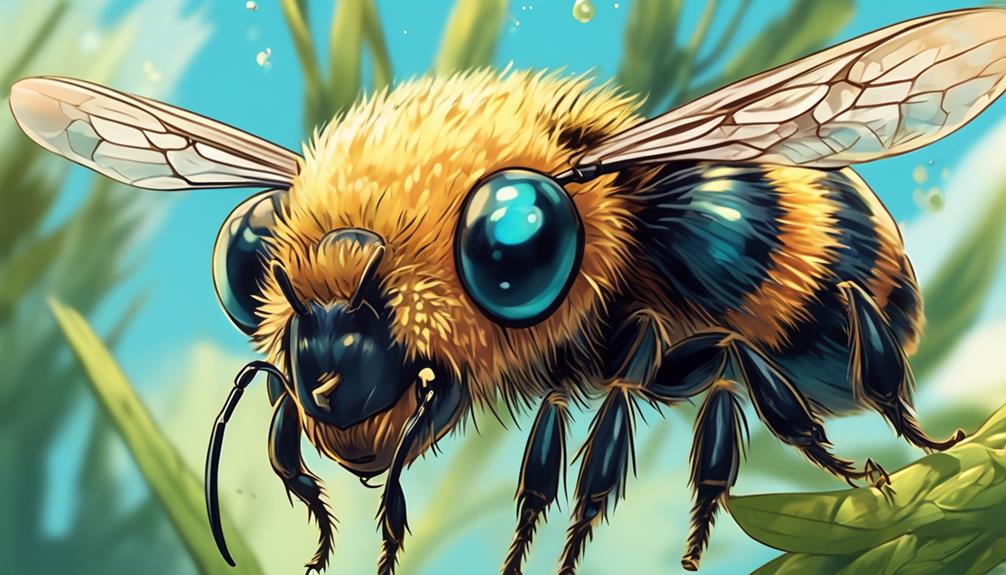Learn about the extraordinary vision of the mason bee, a creature with not one, but five eyes – a mystery waiting to be unraveled.

How Many Eyes Does a Mason Bee Have?
Peering into the world of the mason bee is like opening a book of fascinating secrets. You've likely observed these industrious creatures buzzing busily around your garden, but have you ever stopped to wonder about their vision? It's not as simple as you might think. The mason bee doesn't have one, two, or even three eyes – it has five.
Now, you're probably asking yourself why a creature would need so many eyes. Well, that's a question to stir your curiosity and lead us further into the captivating world of the mason bee.
Key Takeaways
- Mason bees have five eyes, two compound eyes, and three ocelli.
- Compound eyes are composed of thousands of ommatidia, creating a mosaic-like view of the world.
- Ocelli assist in adjusting flight and navigating through complex environments based on light conditions.
- Mason bees' eyesight allows them to independently locate nesting sites and specific flower types, influencing their behavior and leading to efficient solitary work.
Understanding the Mason Bee

To fully appreciate the uniqueness of the Mason Bee, you must delve into its fascinating biological characteristics, starting with its complex visual system. Interestingly, Mason bees, like many other insects, have compound eyes. They're equipped with two large, protruding eyes on the sides of their heads, each composed of thousands of individual facets known as ommatidia. Each ommatidium functions as a separate photoreceptive unit, collecting light and processing images independently, providing the bee with a mosaic-like view of the world.
But there's more. Mason bees also have three additional eyes on top of their heads, known as ocelli. These 'simple eyes' aren't used for forming images like the compound eyes, but they play a crucial role in detecting light intensity, helping the bees navigate under varying light conditions.
Anatomy of a Bee's Vision

Building on this understanding of the Mason bee's unique visual system, let's now examine the intricate anatomy of a bee's vision.
You'll find it fascinating that a bee's vision is unlike ours. It's uniquely adapted to their lifestyle and needs, allowing them to perceive their environment effectively.
A bee's eyes are divided into two types: compound and simple. The compound eyes, larger and more noticeable, are made up of thousands of tiny lenses called ommatidia. Each ommatidium captures a fraction of the visual field, creating a mosaic image. This enables bees to detect fast movements, crucial for escaping predators and foraging.
The simple eyes, or ocelli, are three small, light-sensitive spots on the top of a bee's head. They're not for forming images but for monitoring changes in light intensity. This helps bees maintain orientation and navigate, even in poor light conditions.
Moreover, bees see a different spectrum of light than us. They can't see red but can see ultraviolet light, which is invisible to us. This plays a vital role in their ability to locate nectar-rich flowers, which often reflect UV light.
The world through a bee's eyes is indeed a fascinating study!
Mason Bees: Eyesight and Behavior

Delving into the specific case of Mason bees, you'll find their eyesight and behavior intricately linked and extraordinarily adapted to their solitary lifestyle. Unlike social bees, they don't rely on collective work, so their vision must be sharp enough to independently locate and recognize suitable nesting sites and specific flower types for nectar and pollen.
Mason bees have two types of eyes: compound and simple (ocelli). The compound eyes provide a broad field of view, while the ocelli are crucial for light sensitivity and navigation.
Let's break it down in this table:
Eye Type | Function | Impact on Behavior |
|---|---|---|
Compound Eyes | Broad field of view | Assists in locating and recognizing nesting sites |
Simple Eyes (Ocelli) | Light sensitivity and navigation | Helps in adjusting flight according to light conditions and navigating through complex environments |
These adaptations allow Mason bees to effectively operate in varying light conditions and navigate through complex landscapes. Their eyesight influences their behavior, leading to efficient solitary work. This depth of understanding reveals the incredible adaptability of these fascinating creatures.
Comparing Mason Bees With Other Bees

Now that we've explored the eye structure of Mason bees and its influence on their behavior, let's compare these solitary workers with other types of bees and examine the differences and similarities.
While Mason bees have two large compound eyes and three smaller ocelli, Honey bees, for instance, also share this visual configuration. However, the size, shape, and light sensitivity of the eyes can vary significantly, influencing their visual acuity and color perception. This is largely due to their diverse lifestyles and environments.
You'll find that social bees like Honey bees and Bumble bees have more advanced communication systems, and their vision plays a crucial role in their intricate dances used for locating food sources and navigating back to the hive. On the other hand, solitary bees like the Mason bees, rely more on their sense of smell for foraging and less on vision for communication.
Furthermore, the nocturnal Sweat bees have larger ocelli for better vision in low light, unlike Mason bees that are diurnal. The variations in the eyesight of different bees provide each species with unique adaptations that allow them to thrive in their specific ecological niches.
Unique Features of Mason Bee Eyes

When you take a closer look at Mason bee eyes, you'll discover a host of unique features that distinguish them from other bee species. Firstly, Mason bees have five eyes, two large compound eyes and three small simple eyes or 'ocelli'. These ocelli are arranged in a triangular pattern on top of the bee's head and are used to detect light intensity, rather than forming images.
The compound eyes of Mason bees are fascinating. Composed of thousands of tiny lenses or 'facets', they offer a wide field of view. Each facet captures a small part of the scene, which is then combined to form a complete image. This mosaic vision, as it's called, enables the bee to detect movement quickly, a critical ability for survival.
One other distinctive characteristic is their color vision. Unlike humans, Mason bees see in the ultraviolet spectrum. This ability helps them locate flowers, as many plants reflect UV light, essentially creating a beacon for these bees. Also, the UV vision aids in identifying different types of pollen, vital for their role as prolific pollinators.
Conclusion
So, you've now explored the fascinating world of mason bees. You've learned that these bees, like other insects, have five eyes: two large compound eyes and three smaller ocelli for light detection.
You've compared their vision to other bees and discovered their unique features. Armed with this knowledge, you can now appreciate the complexity and adaptability of these tiny pollinators, an essential part of our ecosystem.
Isn't nature incredible?



